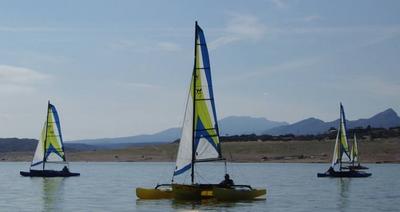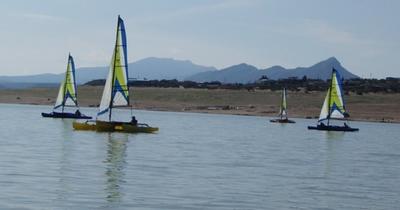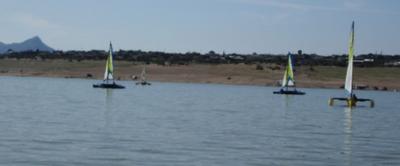How we got our boat.
Years of life in New Mexico had left me feeling a bit.... well, dry. After living there for a couple of years and returning to the Houston/Galveston Bay area for a short visit, I was just a bit desperate for the sight and smell and sound of the water and the taste of succulent fresh seafood. Stopping at a small seafood stand near the bridge in Kemah, I was even able to convince the proprietor to take pity upon me and fill a clamshell plate with nothing but fresh Gulf shrimp and some sauce -- no fries, no hush pupplies, no slaw, just the shrimp and nothing but. I then spent a very happy half hour peeling and eating those wonderful delicate morsels.
However, New Mexico isn't the uniform desert that some outsiders might imagine; it has a varied landscape of deserts, canyonlands, high steppes and rangeland, rolling hills, mountains, and forests. There are even lakes, mostly man-made, with some large enough to attract seabirds and even, dare we say, sailors. We even found that we knew one of these unusual creatures and took a sailboat ride on Heron Lake, but did no more, busy as we were.
But, the sailing bug was growing inside. Some years later, we heard about a sailing club and I started to look at boats at Jack's sailboat yard in Albuquerque and elsewhere during our travels on one or another coast. Trips to visit Carol Anne's brother in San Diego inevitably generated into visits to maritime museums, marinas, chandleries, and other unsavory haunts.
Still, we resisted. Carol Anne thought the price of the boats I was looking at too expensive. Would we stick with the hobby? Was this a real commitment or a passing fad? Would we get enough use out of the boat to justify the expense and trouble? Could we afford it? And so, the weeks rolled by as winter approached and we had no boat.
Yet, interest was high enough that we took our first sailing vacation. In November of '99, en route to visit my father in south Texas for Thanksgiving, I drove Gerald to visit friends in Lewisville and Galveston. I was desperate enough to approach a charter company in Kemah and soon I was talking to skipper Kevin Vennell ("100 ton master") and arranging a half-day skippered charter for that afternoon. We'd originally though to rent a smaller boat, but the skipper suggested something a little bigger to handle the chop stirred up by the winds. With an inexperienced crew, Kevin had us motor out the channel into Galveston Bay and unfurled the big genoa on the thirty-two-foot Kirie Elite sloop. The boat responded well and we had a great afternoon sail, culminating with sunset and then a dusk approach under motor up the channel. But the day wasn't over; we motored on under the bridge a bit into Clear Lake, poking our way around a bit before heading back out and toward the harbor just as the moon emerged overhead. Truly a magical experience.
Carol Anne took a flight down to Texas to join us after finishing teaching and we drove to Corpus Christi. There, at the sailing school, we enjoyed another few great hours of sailing with a skipper on a 41-foot Morgan in Corpus' wide bay.
Christmas 1999 found us in Santa Barbara, California, taking a formal sailing class, basic keelboat sailing, on a J-24, which in the world of boats is rather like a very nimble sports car. It was an interesting time and worth telling about someday on these pages. Learning the language, doing person-overboard drills, and sailing in close quarters to other boats, we acquired some basic knowledge and confidence.
Yet, still, the same questions remained. Could we afford it? Would we really use it? Should we spend that much? And so, we still didn't have a boat, even though at the boatyard there was a boat that I had visited several times that seemed to be calling to me.
One morning I opened an envelope that promised an almost-free meal. That is, we could earn some free dinners by enduring a condo timeshare sales pitch. These sorts of things are rather painful to us, but this one was a pleasant drive away in Santa Fe and didn't look like it would be too gruesome. And, the restaurants where we would get the dinners looked very appealing. So, we bit. We showed up, did the tour, and endured the sales pitch that tended to highlight certain things and gloss over certain other "unimportant details". "We know you can afford this," was one of the sales refrains. "You'll have a place you can count on having one week every year," was another. And so on, with the incomplete math to justify the "investment". Next, the sales "consultant" mentioned the price of a deluxe unit, but without too much hope of selling it.
Then, the salesperson finally got to the amount of money we'd have to pay for the timeshare unit they were most hoping to sell. To within a percentage point, the price was identical to the price of the boat to which I'd been drawn. Carol Anne turned to me. "Yes, we can afford it. We'll get the boat."












